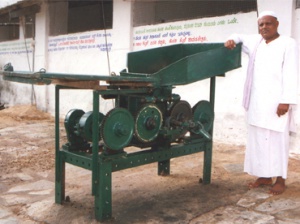Name : Abdul Khadar Nadakattin
District & State : Dharwad, Karnataka
Category : Utility
Award : Lifetime
Award Function : 8th National Grassroots Innovation Awards
Award Year : 2015
Innovator Profile
 Abdul Khadar (62) is an innovator, a social worker and an environmentalist. Believing in the principles of sustainability, he has always advocated cost-effective, eco-friendly and socially acceptable methods in agriculture. He has also developed a number of user friendly and useful innovations.
Abdul Khadar (62) is an innovator, a social worker and an environmentalist. Believing in the principles of sustainability, he has always advocated cost-effective, eco-friendly and socially acceptable methods in agriculture. He has also developed a number of user friendly and useful innovations.
He hails from a place called Annigeri in Navalgund taluka of Dharwad district, which has a population of about twenty five thousand people. Annigeri and the surrounding areas have deep black soil and are well known for chilli and Bengal gram crops. Growing up in a place surrounded by agricultural fields, it was natural for Abdul to have inclination towards agriculture. The only son of his parents, Abdul was keen on going to school but his father wanted him to focus on agriculture solely. Right from childhood he had an observant nature and a very innovative bent of mind, as evident from his first innovation.
A Wa(h!)ter Alarm
No matter how hard he tried, Nadakattin could never get up early in the morning. None of the alarms just seemed to break his slumber. His innovative mind started thinking of a mechanism that could solve this problem. This led him to develop a ‘water alarm’ – his first innovation. He tied a thin rope at the end of the key of the alarm in such a way that when the key unwound itself, the string tied to the key got wound. The string was in turn tied to a bottle filled with water, when the key was completely unwound, the bottle would tilt and the water would fall on his face.
Growing Tamarind
Abdul had inherited 60 acres of land from his father. As in any other dry area, agriculture there faced the risk of unpredictable rain along with scarce groundwater reserve. Facing similar problem and looking for an alternative, he decided to practice horticulture. He planted mango, sapota and ber with chilli as an intercrop in 16 acres of his land. Sapota and ber were planted alternatively in between mango rows. Owing to the lack of sufficient water, the idea failed to take off. He then decided to cultivate tamarind when he observed that in an orchard that was left uncared for a long period, only tamarind plants were standing green and had borne fruits also.
In 1985 – a year of severe drought, he managed to transport water from a distance of two to three km. With much difficulty he planted 600 tamarind plants in pits in rows with spacing of 20 ft. The plants not only survived but continued to grow well. In 1990, inspired by the success he planted 1,100 more plants in ten acres. He thus was able to establish a 16 acre grove with about 1800 tamarind trees.
One Innovation Leads to Another
The success of growing tamarind with scarce but alkaline water was an innovation in itself. To overcome water constraints, he tried reclaiming water by a three-part filtration process and dug as many as eleven bore wells at a cost of two lakhs but only two of them yielded water. Later he dug six farm ponds to harvest rainwater. After monsoon, water from the bore well was used to pump into the ponds. The water was then used for flood irrigating the plants. He has also constructed underground tanks to preserve the pulp of tamarind. Pulp preserved in such a manner had a long shelf-life and could retain the original quality and flavour for a longer period. He then started value addition to the raw fruit by manufacturing pickles and jam. His wife and daughter made the pickle and jam, which was marketed as far as Hyderabad. He thought of another new experiment when he faced problem in making pickles. The process of making pickle was labour intensive and tedious as one had to first harvest tamarind from the trees and then separate seeds from the fruit manually. He conceived a unique technique for harvesting tamarind from the trees but did not go ahead due to high cost involved.
http://nif.org.in/innovation/a-device-to-separate-tamarind-seeds/760
